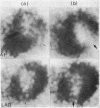Abstract
Two hundred and fifteen patients with previous myocardial infarction were investigated between four and six months after the acute episode by computer assisted 12 lead exercise electrocardiography. Thirty-six (17%) out of this group showed ST segment elevation over the infarct zone, reflected by leads presenting with "QS" configuration. They were further investigated by serial thallium-201 scintigraphy, coronary arteriography, and left ventricular angiography. All showed left ventricular wall motion abnormalities and 89 per cent were diagnosed to have left ventricular "aneurysm" (dyskinesia and akinesia). In a further patient with a posterior aneurysm, the exercise-induced ST elevation could only be detected by using an oesophageal lead. We suggest that these changes reflect severe underlying left ventricular wall motion abnormalities in the presence or absence of reversible myocardial ischaemia. The mechanism of ST segment elevation in this situation, occurring in leads with a "QS" configuration, may be mechanical in the majority of the patients rather than due to reversible myocardial ischaemia.
Full text
PDF
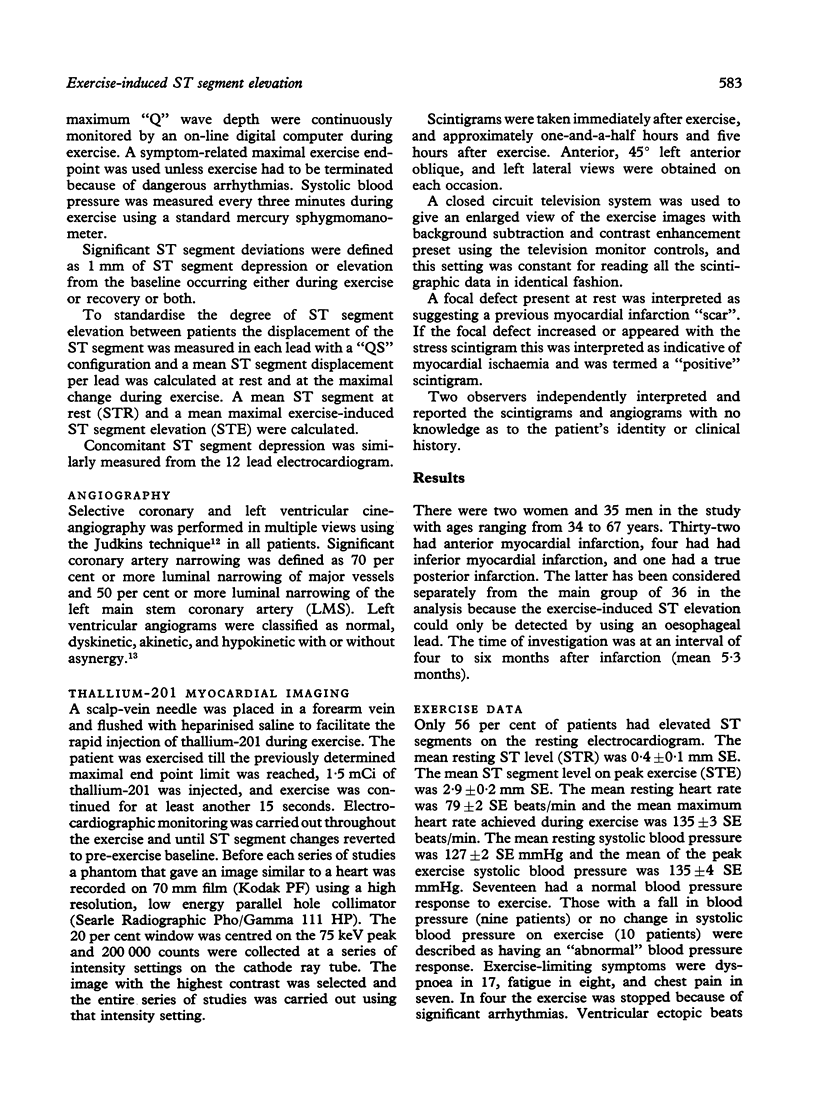
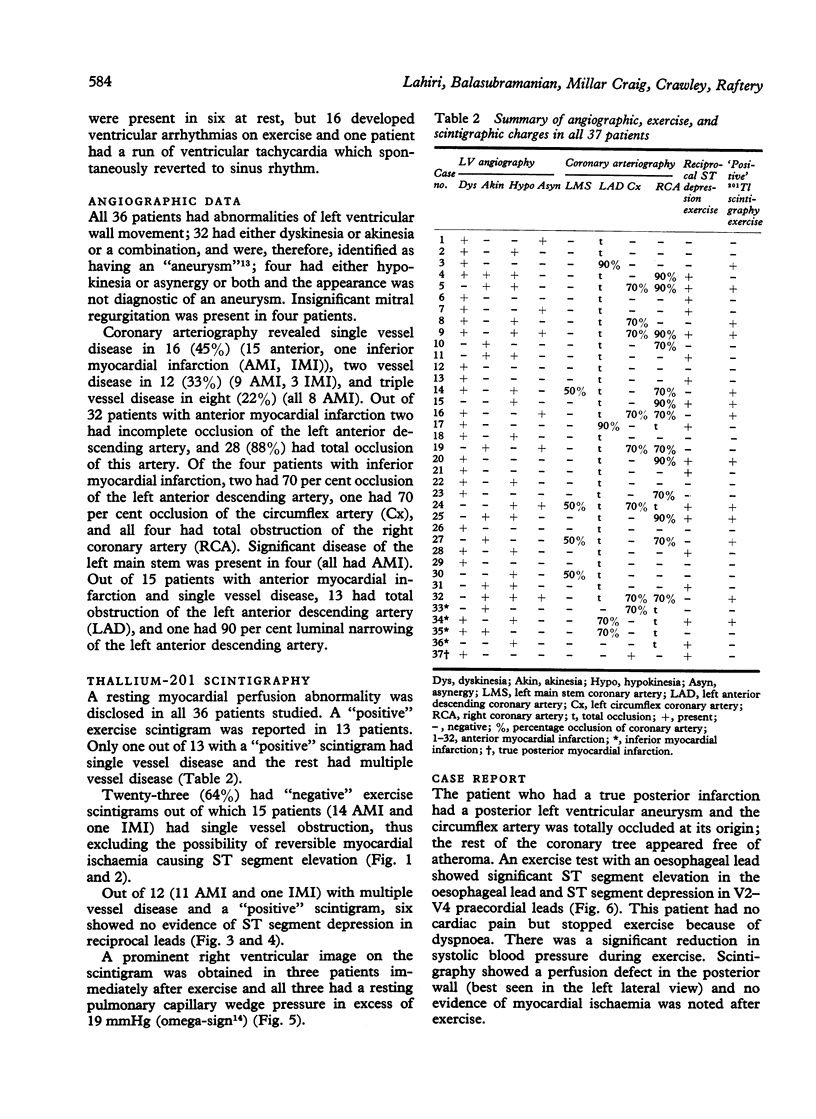
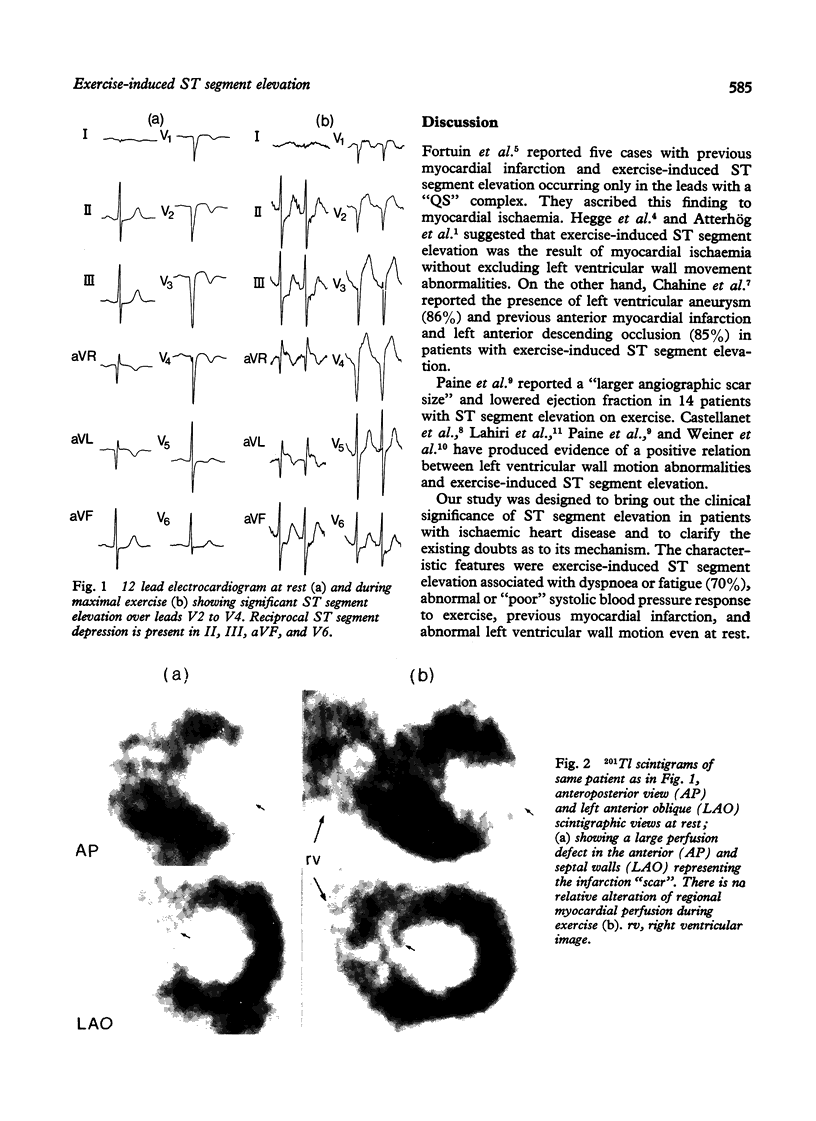
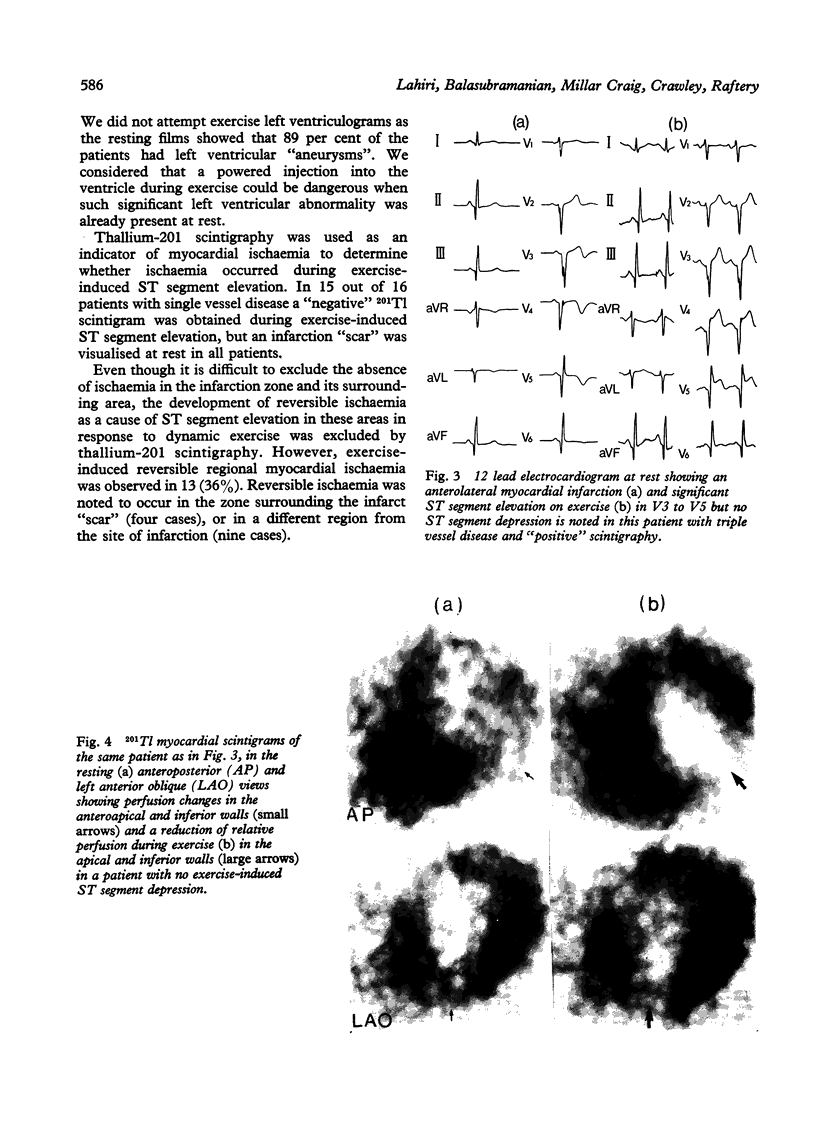
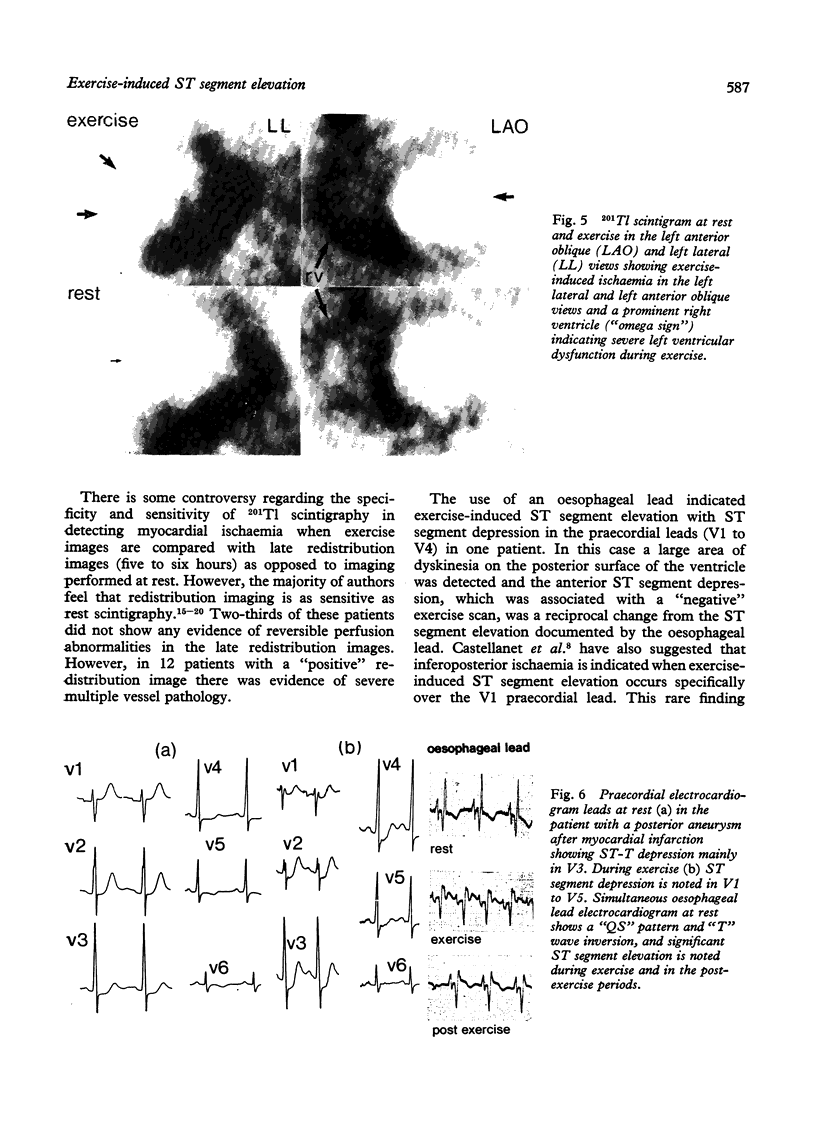

Images in this article
Selected References
These references are in PubMed. This may not be the complete list of references from this article.
- Atterhög J. H., Ekelund L. G., Kaijser L. Electrocardiographic abnormalities during exercise 3 weeks to 18 months after anterior myocardial infarction. Br Heart J. 1971 Nov;33(6):871–877. doi: 10.1136/hrt.33.6.871. [DOI] [PMC free article] [PubMed] [Google Scholar]
- Blood D. K., McCarthy D. M., Sciacca R. R., Cannon P. J. Comparison of single-dose and double-dose thallium-201 myocardial perfusion scintigraphy for the detection of coronary artery disease and prior myocardial infarction. Circulation. 1978 Nov;58(5):777–788. doi: 10.1161/01.cir.58.5.777. [DOI] [PubMed] [Google Scholar]
- Castellanet M. J., Greenberg P. S., Ellestad M. H. Comparison of S-T segment changes on exercise testing with angiographic findings in patients with prior myocardial infarction. Am J Cardiol. 1978 Jul;42(1):29–35. doi: 10.1016/0002-9149(78)90980-3. [DOI] [PubMed] [Google Scholar]
- Chahine R. A., Raizner A. E., Ishimori T. The clinical significance of exercise-induced ST-segment elevation. Circulation. 1976 Aug;54(2):209–213. doi: 10.1161/01.cir.54.2.209. [DOI] [PubMed] [Google Scholar]
- Corne R. A., Gotsman M. S., Atlan H. Radionuclide assessment of regional myocardial perfusion with thallium-201. Am Heart J. 1979 Jan;97(1):112–118. doi: 10.1016/0002-8703(79)90121-2. [DOI] [PubMed] [Google Scholar]
- Fortuin N. J., Friesinger G. C. Exercise-induced S-T segment elevation. Clinical, electrocardiographic and arteriographic studies in twelve patients. Am J Med. 1970 Oct;49(4):459–464. doi: 10.1016/s0002-9343(70)80039-0. [DOI] [PubMed] [Google Scholar]
- Hegge F. N., Tuna N., Burchell H. B. Coronary arteriographic findings in patients with axis shifts or S-T-segment elevations on exercise-stress testing. Am Heart J. 1973 Nov;86(5):603–615. doi: 10.1016/0002-8703(73)90337-2. [DOI] [PubMed] [Google Scholar]
- Herman M. V., Heinle R. A., Klein M. D., Gorlin R. Localized disorders in myocardial contraction. Asynergy and its role in congestive heart failure. N Engl J Med. 1967 Aug 3;277(5):222–232. doi: 10.1056/NEJM196708032770502. [DOI] [PubMed] [Google Scholar]
- Judkins M. P. Percutaneous transfemoral selective coronary arteriography. Radiol Clin North Am. 1968 Dec;6(3):467–492. [PubMed] [Google Scholar]
- Kemp G. L. Value of treadmill stress testing in variant angina pectoris. Am J Cardiol. 1972 Nov;30(7):781–783. doi: 10.1016/0002-9149(72)90155-5. [DOI] [PubMed] [Google Scholar]
- Lahiri A., Raftery E. B., Wilkins R., Craig M. M. Correlation of coronary angiography, left ventricular angiography and graded treadmill exercise testing in the diagnosis of left ventricular aneurysms. Ann Radiol (Paris) 1979 May;22(4):261–263. [PubMed] [Google Scholar]
- MacAlpin R. N., Kattus A. A., Alvaro A. B. Angina pectoris at rest with preservation of exercise capacity: Prinzmetal's variant angina. Circulation. 1973 May;47(5):946–958. doi: 10.1161/01.cir.47.5.946. [DOI] [PubMed] [Google Scholar]
- Manvi K. N., Ellestad M. H. Elevated ST segments with exercise in ventricular aneurysm. J Electrocardiol. 1972;5(4):317–323. doi: 10.1016/s0022-0736(72)80041-4. [DOI] [PubMed] [Google Scholar]
- McCarthy D. M., Blood D. K., Sciacca R. R., Cannon P. J. Single dose myocardial perfusion imaging with thallium-201: application in patients with nondiagnostic electrocardiographic stress tests. Am J Cardiol. 1979 May;43(5):899–906. doi: 10.1016/0002-9149(79)90351-5. [DOI] [PubMed] [Google Scholar]
- Paine T. D., Dye L. E., Roitman D. I., Sheffield L. T., Rackley C. E., Russell R. O., Jr, Rogers W. J. Relation of graded exercise test findings after myocardial infarction to extent of coronary artery disease and left ventricular dysfunction. Am J Cardiol. 1978 Nov;42(5):716–723. doi: 10.1016/0002-9149(78)90089-9. [DOI] [PubMed] [Google Scholar]
- Pohost G. M., Zir L. M., Moore R. H., McKusick K. A., Guiney T. E., Beller G. A. Differentiation of transiently ischemic from infarcted myocardium by serial imaging after a single dose of thallium-201. Circulation. 1977 Feb;55(2):294–302. doi: 10.1161/01.cir.55.2.294. [DOI] [PubMed] [Google Scholar]
- Rosenblatt A., Lowenstein J. M., Kerth W., Handmaker H. Post-exercise thallium-201 myocardial scanning: a clinical appraisal. Am Heart J. 1977 Oct;94(4):463–470. doi: 10.1016/s0002-8703(77)80041-0. [DOI] [PubMed] [Google Scholar]
- Sonnemaker R. E., Floyd J. L., Nusynowitz M. L., Bode R. F., Spicer M. J., Waliszewski J. A. Single injection thallium-201 stress and redistribution myocardial perfusion imaging: comparison with stress electrocardiography and coronary arteriography. Radiology. 1979 Apr;131(1):199–203. doi: 10.1148/131.1.199. [DOI] [PubMed] [Google Scholar]
- Weiner D. A., McCabe C., Klein M. D., Ryan T. J. ST segment changes post-infarction: predictive value for multivessel coronary disease and left ventricular aneurysm. Circulation. 1978 Nov;58(5):887–891. doi: 10.1161/01.cir.58.5.887. [DOI] [PubMed] [Google Scholar]




